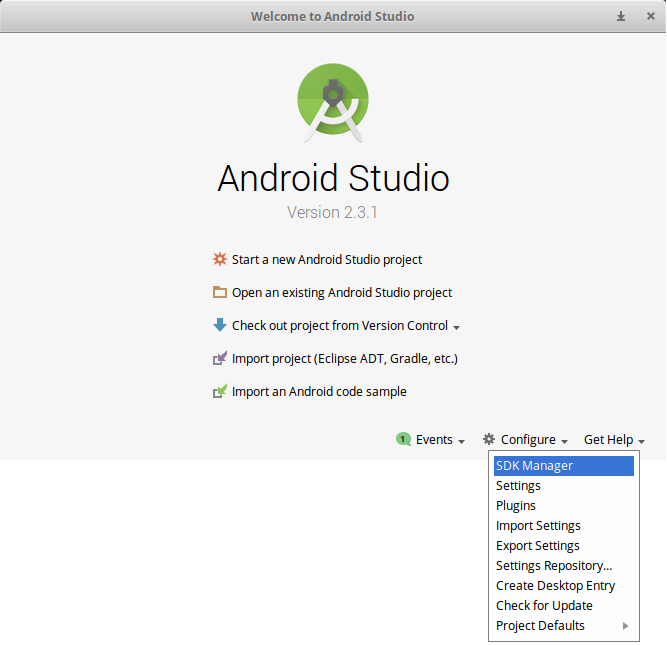Before we dive in to the actual development, we need to do some preparation work.
1. Installation
First step is to make sure you got the Cordova CLI installed and the necessary SDKs.
$ npm install -g cordova
WARNING
Depending on your version of Android Studio, you might need to re-enable the “Android SDK Tools”. You can do this by going to “Tools > SDK Manager > SDK Tools” then un-ticking “Hide Obsolete Packages” and tick “Android SDK Tools (Obsolete)”. The instructions below assume this has been done.
WARNING
The environmental variable ANDROID_HOME has been deprecated and replaced with ANDROID_SDK_ROOT. Depending on your version of Android Studio you may need one or the other. It doesn’t hurt to have both set.
Android setup
After this step you will need to install the Android platform SDK on your machine. You can download the Android Studio here and follow these installation steps afterwards.
Make sure that after you install the Android SDK you then accept its licenses. Open the terminal and go to the folder where the SDK was installed, in tools/bin and call
sdkmanager --licenses.Add Android installation to your path:
Unix (macOS, linux)
export ANDROID_HOME="$HOME/Android/Sdk"
export ANDROID_SDK_ROOT="$HOME/Android/Sdk"
export PATH=$PATH:$ANDROID_SDK_ROOT/tools; PATH=$PATH:$ANDROID_SDK_ROOT/platform-tools
Please note that sometimes the
/Android/Sdkfolder is added inside/Library/inside your user folder. Check your user folder and if the/Android/folder is only inside/Library/do:export ANDROID_SDK_ROOT="$HOME/Library/Android/Sdk"orexport ANDROID_HOME="$HOME/Library/Android/Sdk"instead.
Windows
After installing Android Studio, you need to install two more pieces of software:
- JDK from Oracle. It can be found here
- Gradle. It used to usable from Android Studio but now you have to install it separately. There is a very specific version that cordova requires. You can download it here
Then you will have to set environment variables. You will need to set the following variables. Cordova has a good guide for it already. It can be found here. You need to:
- add ANDROID_SDK_ROOT. It can safely be set to: “%USERPROFILE%\AppData\Local\Android\Sdk”
- add two ANDROID_SDK_ROOT directories to your path: %ANDROID_SDK_ROOT%\tools;%ANDROID_SDK_ROOT%\platform-tools
- add Gradle to your path. Note that gradle does not have an installer. You just put the binary files where you want them, then add the bin directory to your path.
If you have an init script for your command prompt or powershell, you can try this:
setx ANDROID_HOME "%USERPROFILE%\AppData\Local\Android\Sdk"
setx ANDROID_SDK_ROOT "%USERPROFILE%\AppData\Local\Android\Sdk"
setx path "%path%;%ANDROID_SDK_ROOT%\tools;%ANDROID_SDK_ROOT%\platform-tools;<gradle_path>\bin;"
After the tools are installed, setup Android Studio with the correct SDK and create a virtual machine.
Start Android studio (check the executable in the folder that you installed it in). Next step is to install the individual SDKs:
Open the “Configure” menu at the bottom of the window:

Select the desired SDKs. As per December 2019 Cordova requires android-28 (Android 9.0 - Pie) so be sure to include it. Click on “Apply” to install the SDKs.

iOS setup
You will need a macOS with Xcode installed. After you’ve installed it, open Xcode in order to get the license prompt. Accept the license, then you can close it.
2. Add Cordova Quasar Mode
In order to develop/build a Mobile app, we need to add the Cordova mode to our Quasar project. What this does is that it uses Cordova CLI to generate a Cordova project in /src-cordova folder. /src-cordova/www folder will be overwritten each time you build.
$ quasar mode add cordova
3. Add Platform
To switch to the cordova project, type:
$ cd src-cordova
Target platforms get installed on demand by Quasar CLI. However, if you want to add a platform manually, type:
$ cordova platform add [android|ios]
To verify that everything is in order, type:
$ cordova requirements
On some newer Debian-based operating systems you might face a very persistent problem when running
cordova requirements. Please see the “Android SDK not found” after installation section for assistance.
Switching to iOS WkWebView
Switching to WKWebView is highly recommended (but optional!) as UIWebView has been deprecated in iOS 12.0 as described in this Cordova blog post: https://cordova.apache.org/news/2018/08/01/future-cordova-ios-webview.html.
However, choose wisely if you want to replace the default webview. Each comes with its own caveats. Make sure that you visit the link above.
Option 1: Ionic Webview Plugin
- Install Ionic Webview Plugin
# from /src-cordova
$ cordova plugin add cordova-plugin-ionic-webview
- Add ScrollEnabled Preference to Config.xml
<platform name="ios">
<preference name="ScrollEnabled" value="true" />
</platform>
- Consult Ionic Docs for caveats on WkWebViewPlugin
- https://beta.ionicframework.com/docs/building/webview
- https://github.com/ionic-team/cordova-plugin-ionic-webview
Option 2: Cordova WkWebviewEngine Plugin
- Install Cordova WkWebviewEngine Plugin
# from /src-cordova
$ cordova plugin add cordova-plugin-wkwebview-engine
- For caveats and more info, visit: https://github.com/apache/cordova-plugin-wkwebview-engine
4. Start Developing
If you want to jump right in and start developing, you can skip step #2 and #3 commands and issue one of the commands below. If you have a mobile/tablet device connected to your machine, you can also run the dev app on it instead of in an emulator.
$ quasar dev -m cordova -T [android|ios]
# passing extra parameters and/or options to
# underlying "cordova" executable:
$ quasar dev -m ios -- some params --and options --here
# when on Windows and using Powershell:
$ quasar dev -m ios '--' some params --and options --here
This will add Cordova mode and project automatically, if it is missing.
However, if you wish to open the IDE (Android Studio / Xcode) and from there to manually select the emulator (or multiple ones simultaneously!) to run the dev app on it/them:
$ quasar dev -m [ios|android] --ide
WARNING
In Android Studio, you will be greeted with a message recommending to upgrade the Gradle version. DO NOT UPGRADE GRADLE as it will break the Cordova project. Same goes for any other requested upgrades.

If you encounter any IDE errors then click on File > Invalidate caches and restart.


